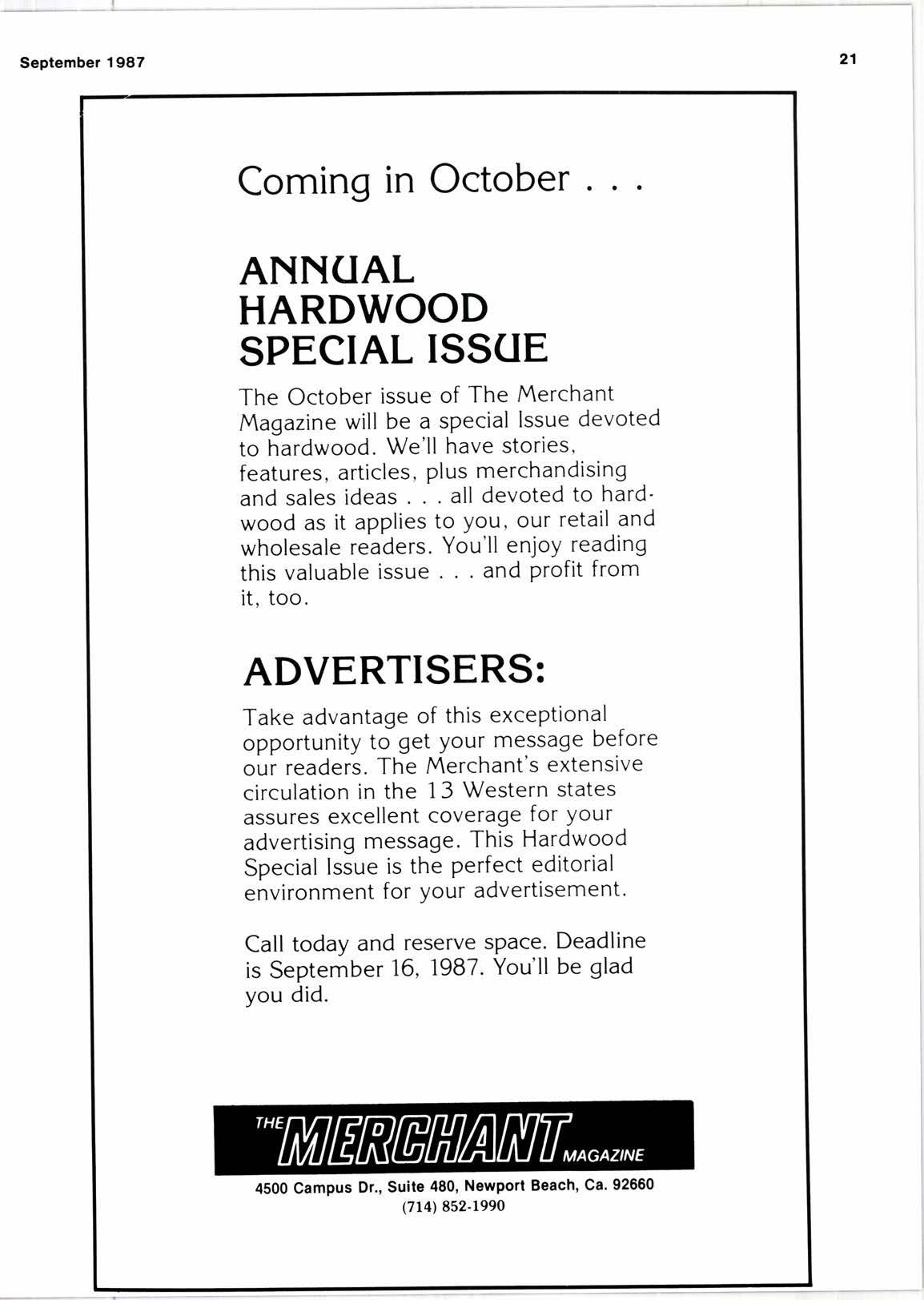
9 minute read
Coming in October . . . ANNUAL HARDWOOD SPECIAL ISSUE
The October issue of The Merchant Magazine will be aspecial Issue devoted to hardwood. We'll have stories, features, articles, plus merchandising and sales ideas . . . all devoted to hard' wood as it applies to you, our retail and wholesalereaders. You'll enjoy reading this valuable issue . and profit from it, too.
ADVERTISERS:
Take advantage of this exceptional opportunity to get your messagebefore our readers. The Merchant's extensive circulation in the 13 Western states assures excellent coverage for your advertising message. This Hardwood Special Issue is the perfect editorial environment for your advertisement.
Call today and reserve sPace. Deadline is September 16, 1987. You'll be glad you did.
BuildingProducts Profits Up
Sales of building products topped their previous year value by 9% during the first quarter of 1987. With average prices of building materials up barely 1olo over the past year, manufacturers relied on tight cost control to achieve a 500/o (median) improvement in profits, according to an analysis of industry sales and earnings.
"The combination of stronger sales and ;;:rther belt-tightening paid off handsomely for the building products industry in the first quarter, when careful management of costs helped to raise profit margins from the year-ago rate of 3 .70/o of sales to a strong 4.90/0. By retaining an additional penny of every dollar from its $45 billion of first quarter sales, the industry earned itself a bonus of some $500 million," George A. Christie, vice president and chief economist for McGraw-Hill's Construction Information Group, pointed out.
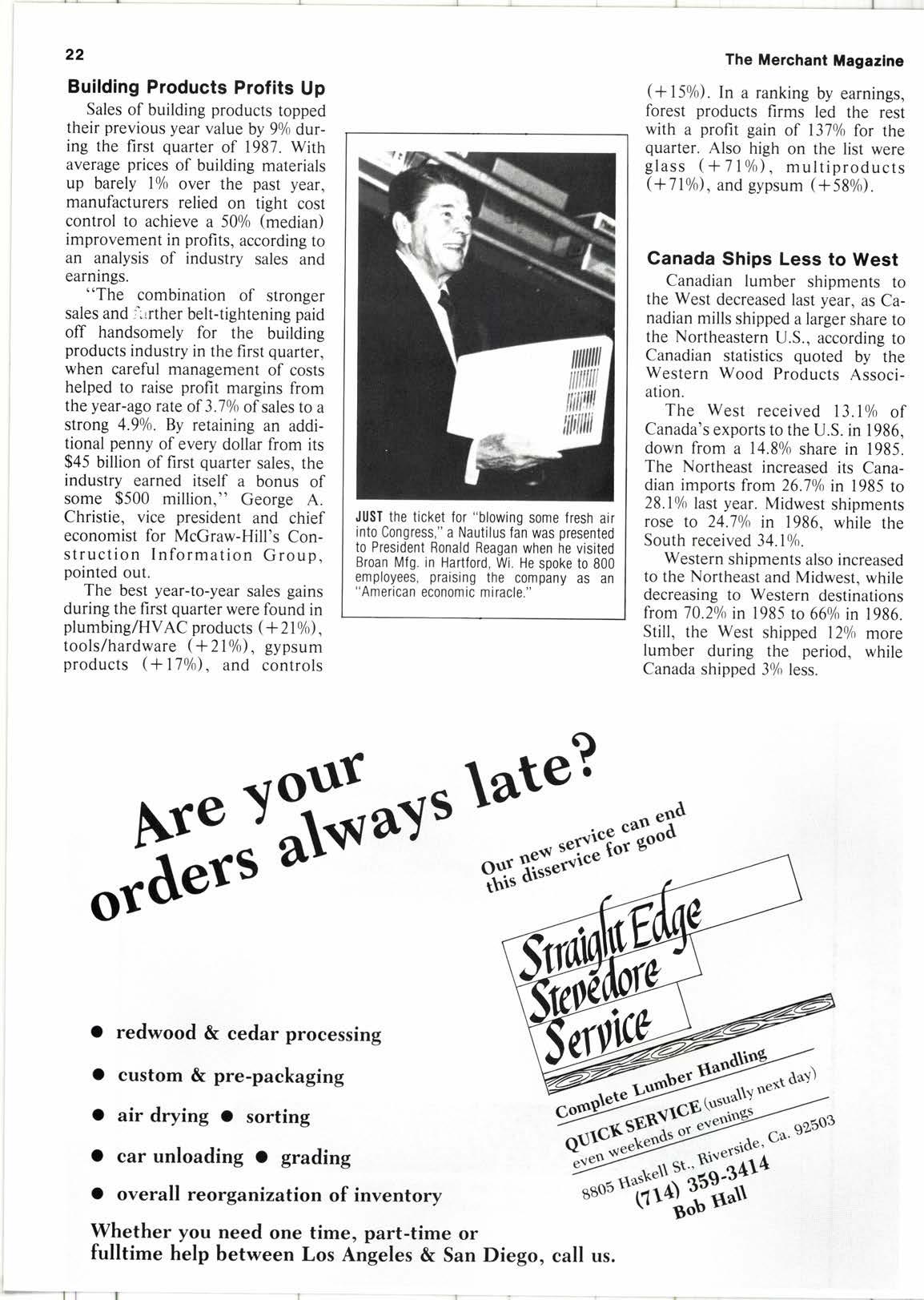
The best year-to-year sales gains during the first quarter were found in plumbing/HVAC products (+ 2l%), tools/hardware (* 210/o), gypsum products (+ tlo/o), and controls
The Merchant Magazlne
(*150/o). In a ranking by earnings, forest products firms led the rest with a profit gain of l37o/o for the quarter. Also high on the list were glass(+710/o), multiproducts (*7lo/o), and gypsum (+58%).
Canada ShipsLess to West
Canadian lumber shipments to the West decreasedlast year, as Canadian mills shipped a larger share to the Northeastern U.S., according to Canadian statistics quoted by the Western Wood Products Association.
The West received l3.lolo of Canada's exports to the U.S. in 1986, down from a 14.80/o share in 1985. The Northeast increased its Canadian imports from 26.70/o in 1985 to 28.1% last year. Midwest shipments rose to 24.70/o in 1986, while the South received 34.10/o.
Western shipments also increased to the Northeast and Midwest, while decreasing to Western destinations from 70.20/o in 1985 to 660/o in 1986. Still, the West shipped 12% more lumber during the period, while Canada shipped 3% less.
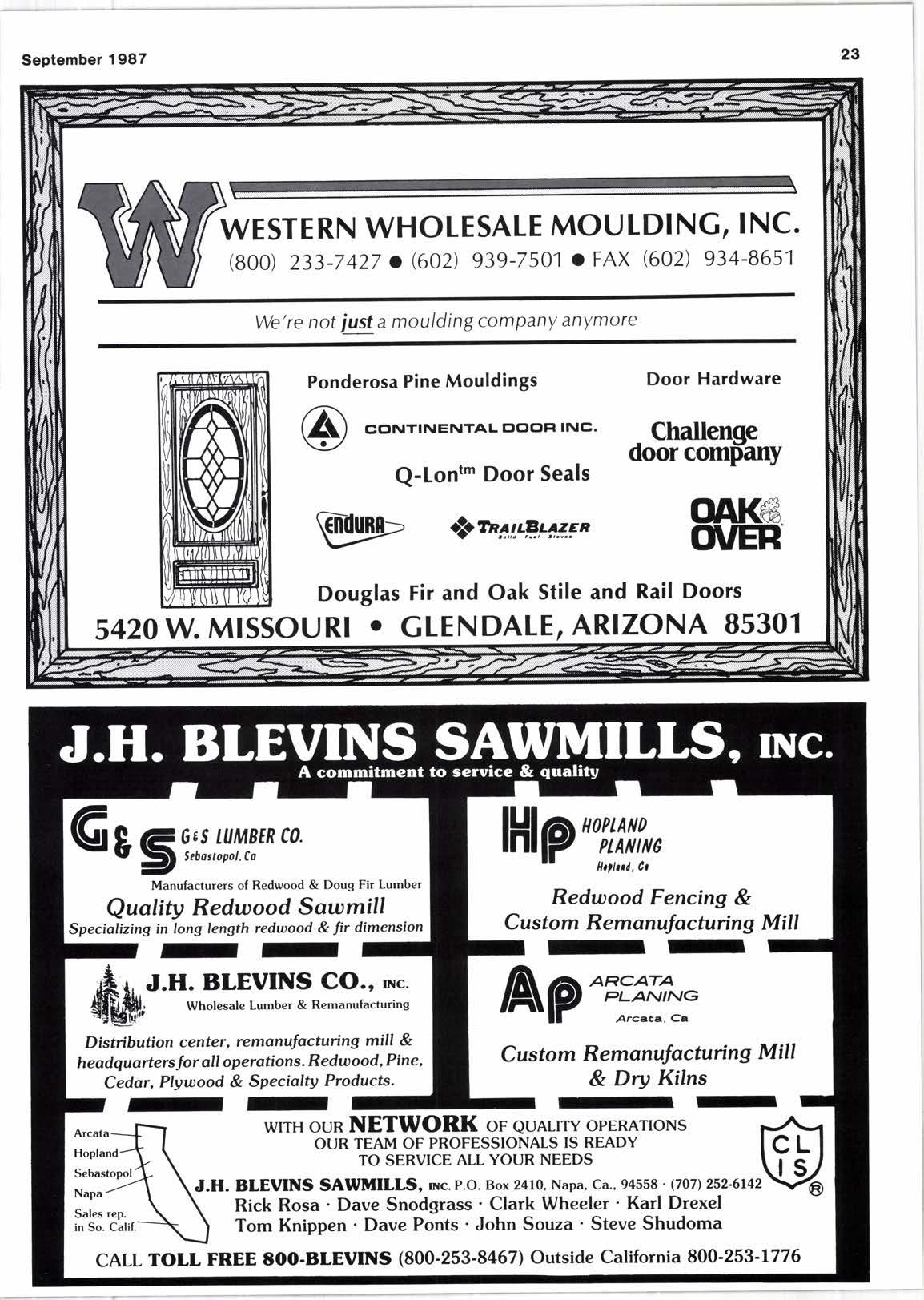
QualitySells Housewares
Quality is the primary reason buyers choose specific housewares, according to manufacturers of small appliances. When a consumer perceives value, he or she has no trouble with the price tag.
"Consumers are showing a strong preference for simple, well-made, small appliances - ones that are versatile and designed to do the job right," says Hal Rosenbaum, of Sunbeam Appliance Co. "The era of disposability is dead, people want sturdy, attractive, high quality merchandise.
"Traditional values have combined with more recent ones, such as upscale women's expectations for equal rights households, to create a desire for better things," says Rosenbaum. "And certain, relatively large segments of society now also have more money to spend."
Thomas Kieckhafer, West Bend Co., has noticed that "because of reduced shelf space for product display, companies no longer have the luxury of bringing out products in many designsandcolors. As a result, products are standing more on their own merit, on features and quality. A good price-value relationship is very important in today's competitive environment.
The price that consumers are willing to pay for housewares directly corresponds to their perception of the product's utility or quality.
"ln this industry, manufacturers tend to follow each other: when one company introduces an even marginal difference to a product, others copy it. But now customers want to see real improvement, realenhanced utility, before they pay extra," says Rosenbaum.
As a result of shifting consumer values, cordless and under-thecabinet appliances are generally not faring well in the market.
"The problem with cordless appliances is one of performance perception," explains Rosenbaum. "A cordless product might not work as well as the corded versionl handmixers, for example, don't seem to have as much power. At the same time, rendering an appliance cordless and rechargeable is expensive, so these
The Merchant Magazlne products cost more. And I don't think that buyers see any real additional value."
Sales of under-the-cabinet appliances are similarly hurt."
CancerDonationsSought
The Los Angeles Hoo-Hoo Club is seeking donations to the American Cancer Society as part of the club's annual presentation of the Ken Coleman Mr. Hoo-Hoo award.
The lumbermen's fraternity will make the first annual presentation to the industry member who hasmade the most outstanding contributions to the club at their meeting Oct. l6 at the Anaheim Hills Country Club, Anaheim, Ca. The award is a memorial to Coleman, a long and active member and former club president, who died May 3, 1986, of lung cancer.
The club is donating $500 to the American Cancer Society as part of the presentation and seeks additional contributions that can be added to their initial donation in honor of Coleman.
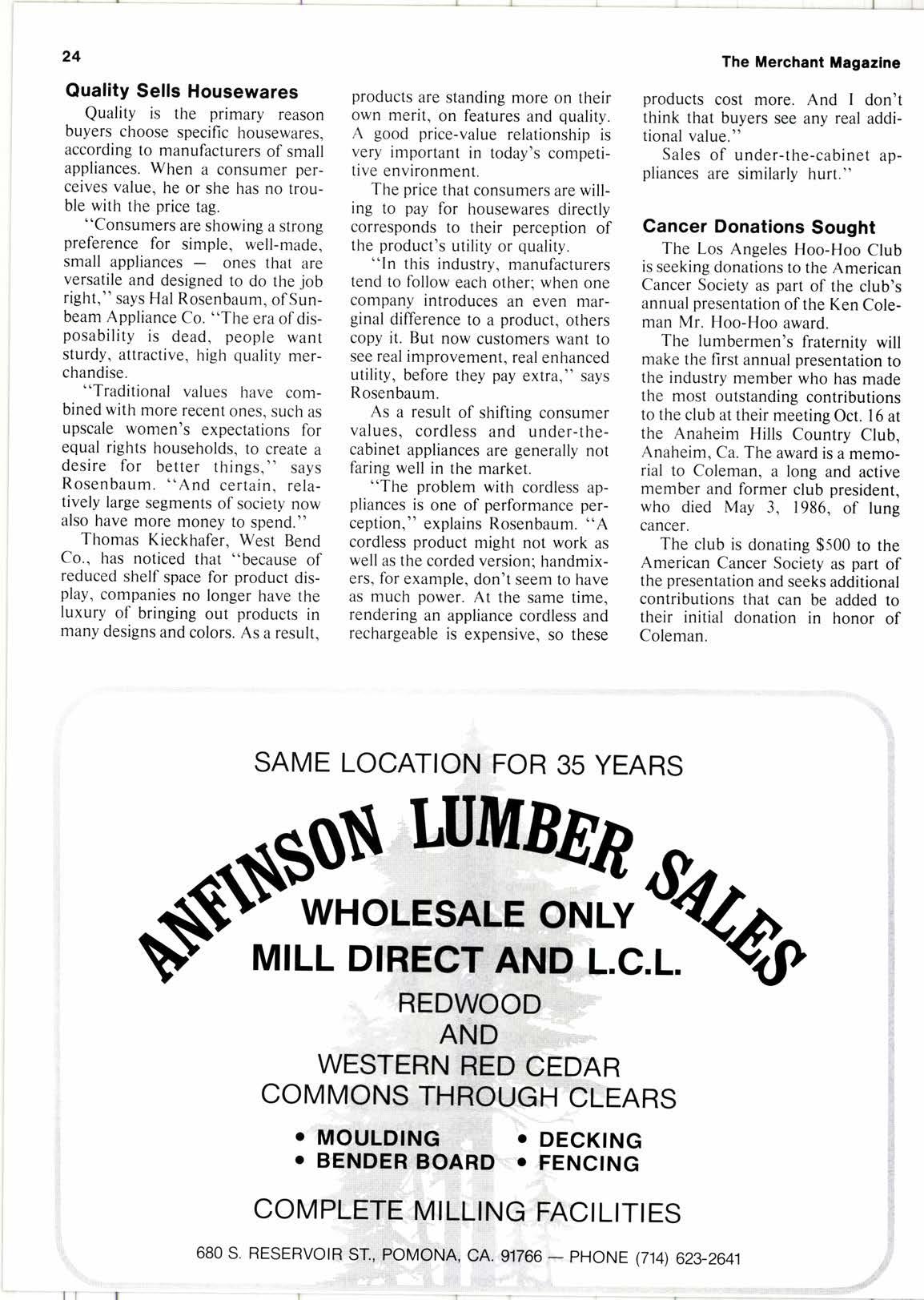

I nECEUf editorial by William Fl Renfro in Vanguard, an ASAE publication, makes some statements that might cause an eyebrow to raise here and there. No, it wasn't about overthrowing the government or changing distribution patterns to eliminate the retail and wholesale lumber distributor. or a myriad of other social problems that confront the world.
It was on thethird millenium. It was futurist thinking. Pretty heavy stuff for those who don't think past the next weekend.
There is an association formed for the people and groups that are futurists, looking and planning toward the new century, the year 2000 and beyond.
According to the editorialist, the first teenagers of the millenium will be born
The Merchant llagazlne
New Years Day 1988. The first lawyers will start the 5th grade this year and the first doctors will be starting in the 8th grade. We should be able to identify now who the leaders of the association will be in the new millenium. The educational system has hnished its work for this millenium.
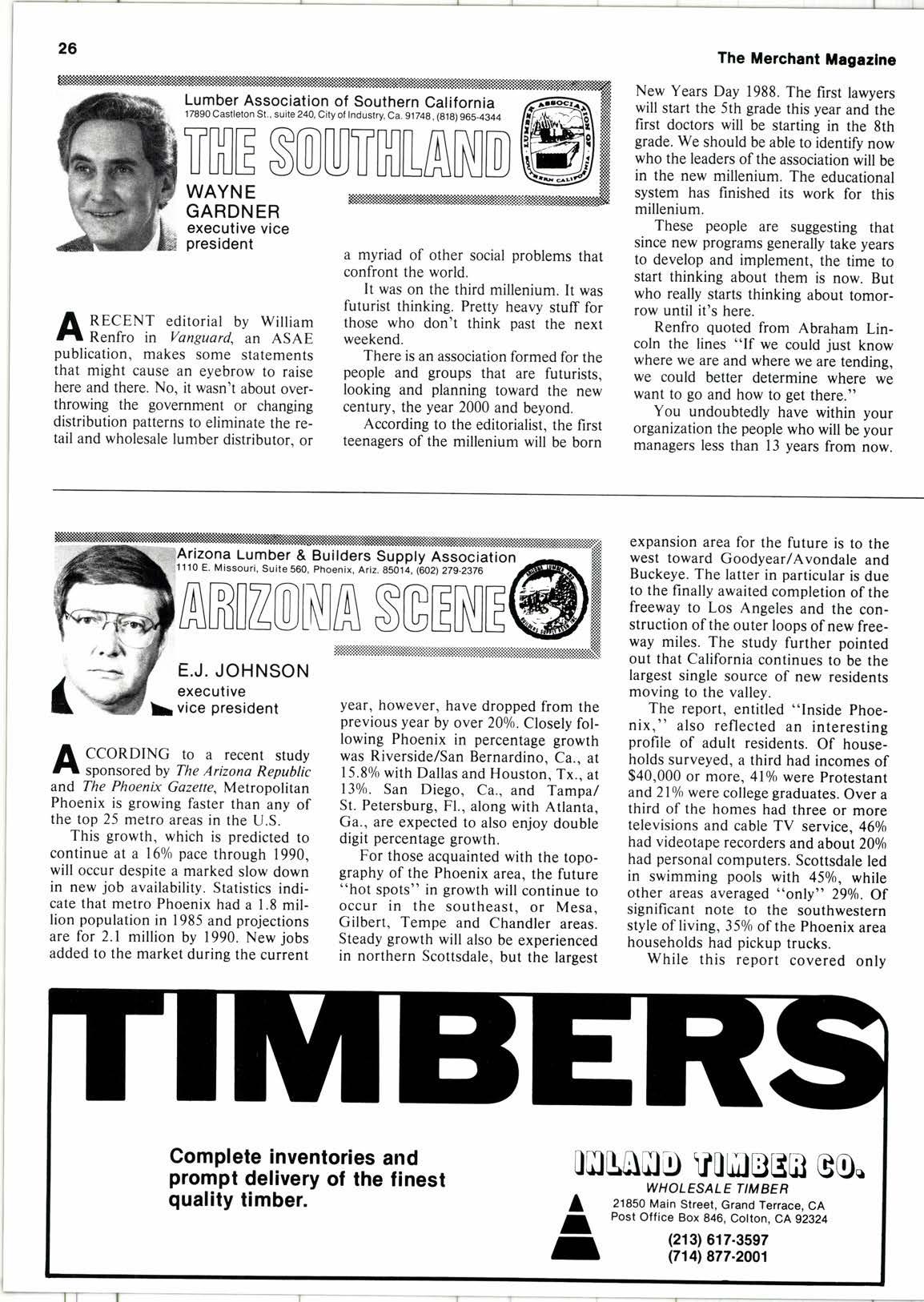
These people are suggesting that since new programs generally take years to develop and implement, the time to start thinking about them is now. But who really starts thinking about tomorrow until it's here.
Renfro quoted from Abraham Lincoln the lines "If we could just know where we are and where we are tending, we could better determine where we want to go and how to get there."
You undoubtedly have within your organization the people who will be your managers less than 13 years from now.
E.J. JOHNSON executive Lr vice president
I cconolNG to a recent study sponsoredby The Arizona Republic and The Phoenix Gazette, Metropolitan Phoenix is growing faster than any of the top 25 metro areas in the U.S. This growth, which is predicted to continue at a 160/o pace through 1990, will occur despite a markedslow down in new job availability. Statistics indicate that metro Phoenix had a 1.8 million population in 1985 and projections are for 2.1 million by 1990. New jobs added tothe market during the current year,however, have dropped from the previous year by over 200/0. Closely following Phoenix in percentage growth was Riverside/San Bernardino, Ca., at 15.80/o with Dallas and Houston, Tx., at l3ol0. San Diego, Ca., and Tampa/ St. Petersburg, Fl., along with Atlanta, Ga., are expected to also enjoy double digit percentage growth.
For those acquainted with the topography of the Phoenix area, the future "hot spots" in growth will continue to occur in the southeast, or Mesa, Gilbert, Tempe and Chandler areas. Steady growth will also be experienced in northern Scottsdale, but the largest expansion area for the future is to the west toward Goodyear/Avondale and Buckeye. The latter in particular is due to the finally awaited completion of the freeway to Los Angeles and the construction ofthe outer loops ofnew freeway miles. The study further pointed out that California continues to be the largestsingle source of new residents moving to the valley.
The report, entitled "lnside Phoenix," also reflected an interesting profile of adult residents. Of households surveyed, a third had incomes of $40,000 or more, 4lVo were Protestant and 270/o were college graduates. Over a third of the homes had three or more televisions and cable TV service, 460lo had videotape recorders and about 200/o had personal computers. Scottsdale led in swimming pools with 45%. while other areas averaged "only" 290/0. Of significant note to the southwestern style of living, 350/o ofthe Phoenix area households had pickup trucks.
While this report covered only
Do thel' or will they know where the! aregoing? l)o the-v- have the ability to build and ntotivate a team. the abilitl' to see the game changing. abilitl to balance a respect fbr others $'ith a sense of'decision. broad experience and talent not taught in classroont. ability to understand the corporale interface with outsicle constituents, the ability to function as a highly infbrntecl. technicalll. competcnl opportunist'l metropolitan Phoenix. it is important for readers to be aware of equall.'- significant gro$th in Tucson and the other outll'ing areas of' the state. With the soon to be completed linkof the Central Arizona Projecl carrying Colorado River water through Phoenix to Tucson, previous constraints to growth will be somewhat alleviated in southern Arizona, It is also accurate to share with readers of this column. that to the lumber interests of this state. growth is a Valued factor to an already keen and competitive industry. But then again' isn't that what private cnterprise is all about'l
.\ 10001, open nlincl. intlnite patience to listen. tell and help. cognizance that historical dates uill beconle irrelevant and internationalitla multi lingual global play er.
'['his person isthe one who will take cverylhing that is thrown at him as a young ntanager and loctk lbr nlore.
Thc millenium\\hat an excltlng opportunitl tbr not onll the voung but the the loung in heart and sPirit.
Sce vou there.
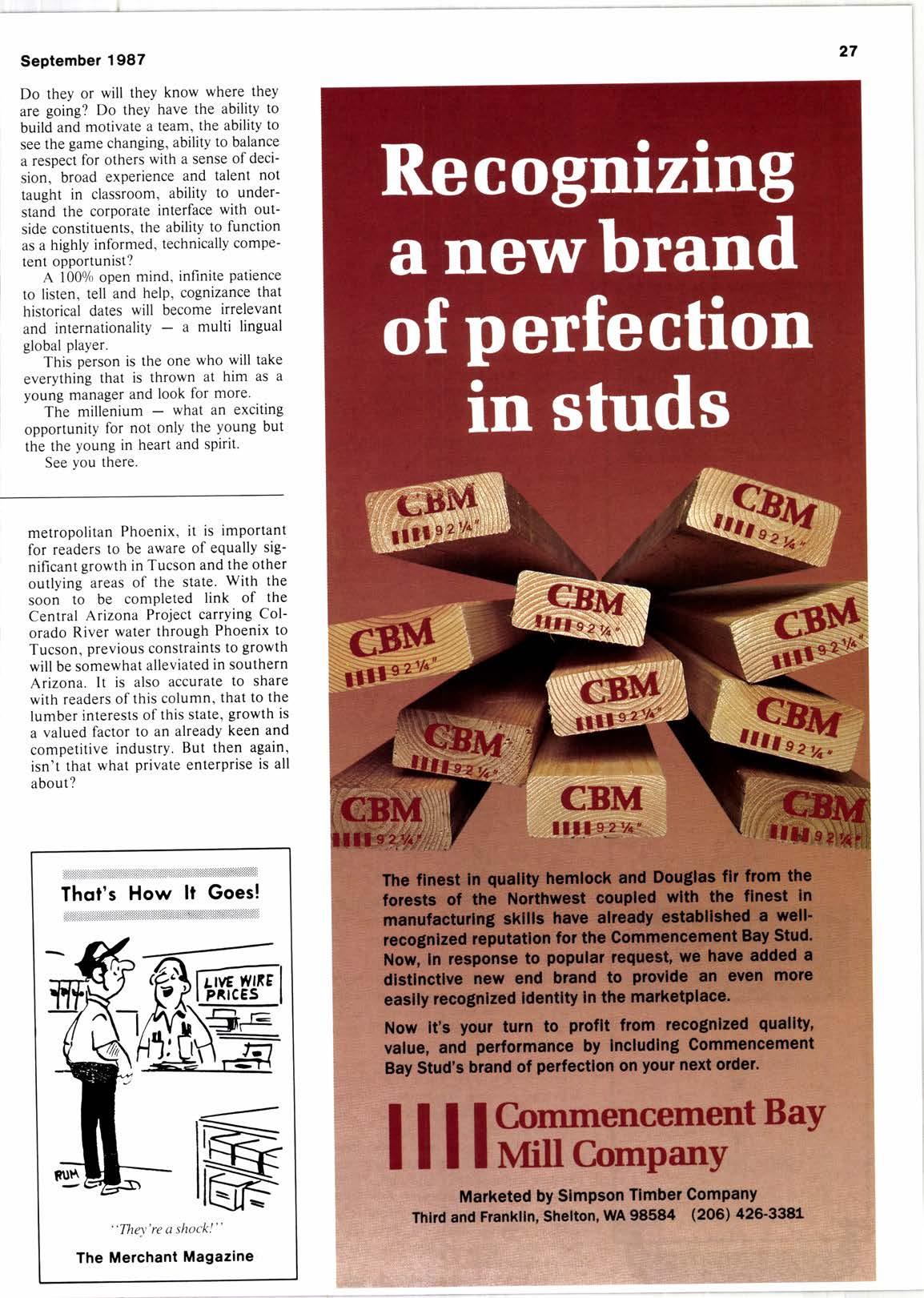
Thof's How lt Goes!
The finsst ln quality hemlock and Douglac flr from the forests of the Northweqt coupled rvlth theflnest ln manufacturlng skllls have already establlsh€d a well' recognized reputatlon for the Commencement Bay Stud. ttow, ln response to popular request' we have €dded a dlstlnctlve new end brand to provlde an even more easlly recognlzed ldentlty In the marketplace' Now lt's your turn to profltfrom recognlzed quallty' value, and performance by Includlng Commencement Bay Stud's brand of perfectlon on your next order.
GARY L. SMITH executive vice president
AVE you ever noticed that it's your best employees that you can't seem to keep busy? This assumes your staff is of adequate size to get the job done, not so harried that they never get caught up.
It's diflicult to keep good people busy because as managers we've become accustomed to having to keep an eye on our employees so they don't goof off. A person who throws everything into a task and completes it quickly and accurately can take us by surprise. Just as we use a very small portion ofour mental capacity because we don't know how to challenge it enough, we all may be wasting part of the resource available from our top employees. lf we're not careful, we may even lose the employee entirely.
My wife is presently seeking a new job. She is prepared to leave her present position that is within walking distance ofour home, pays an adequate wage and offers great flexibility to take care of her outside interests, flor one with a 40 minute commute each way, stricter hours and only slightly higher wages which will be offset by bridge tolls, vehicle gas and maintenance. She's leaving because she is bored and unchallenged. I left my former position partly for the same reasons.
As owners and managers ofyour businesses it is important that you recognize the needs of your best employees beyond just paying them well and giving them "strokes." lt's vital thatyou keep their heads in the business. Share with them your concerns for your business: where it's been and where it's going. Be willing to give up some authority if sharing a challenging task will renew their
(Please turn to page 39)
FRED CARUSO executive secretary
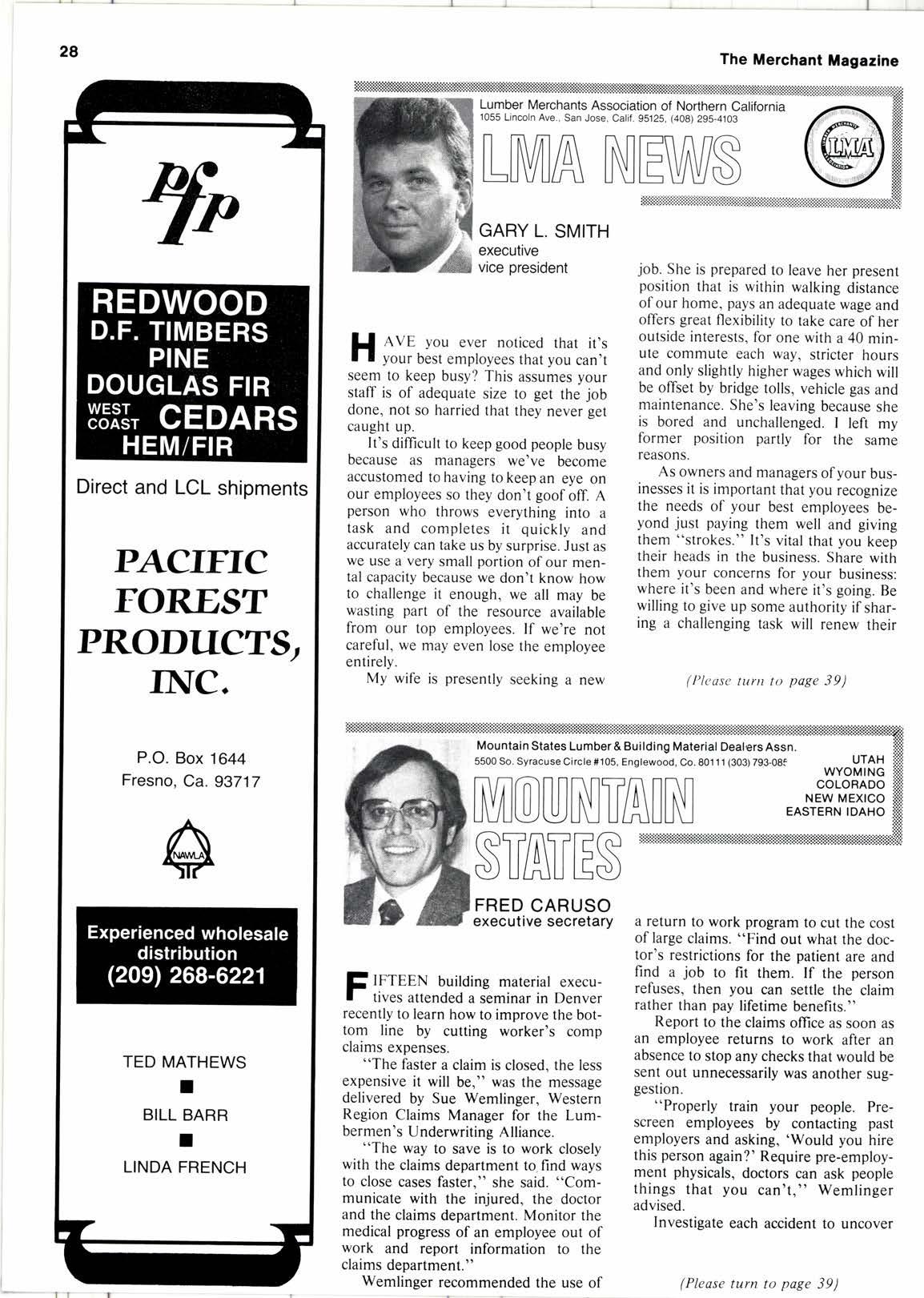
! tFrEeN building material execu- I tives attended a seminar in Denver recently to learn how to improve the bottom line by cutting worker's comp claims expenses.
"The faster a claim is closed, the less expensive it will be," was the message delivered by Sue Wemlinger, Western Region Claims Manager for the Lumbermen's Underwriting Alliance.
"The way to save is to work closely with the claims department to, find ways to close cases faster," she said. "Communicate with the injured, the doctor and the claims department. Monitor the medical progress of an employee out of work and report information to the claims department."
Wemlinger recommended the use of a return to work program to cut the cost of large claims. "Find out what the doctor's restrictions for the patient are and find a job to fit them. lf the person refuses, then you can settle the claim rather than pay lifetime benefits."
Report to the claims office as soon as an employee returns to work after an absence to stop any checks that would be sent out unnecessarily was another suggestion.
"Properly train your people. Prescreen employees by contacting past employers and asking, 'Would you hire this person again?' Require pre-employment physicals, doctors can ask people things that you can'1," Wemlinger advised.
Investigate each accident to uncover










